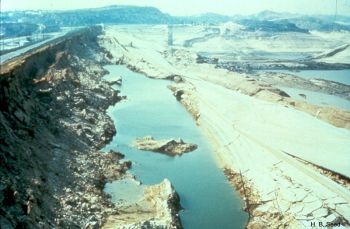Seismic: Difference between revisions
Rmanwaring (talk | contribs) No edit summary |
No edit summary |
||
| Line 47: | Line 47: | ||
{{Video Icon}} [[On-Demand Webinar: Seismic Stability Evaluation of Earth Dams]] | {{Video Icon}} [[On-Demand Webinar: Seismic Stability Evaluation of Earth Dams]] | ||
{{Video Icon}} [[On-Demand Webinar: Earthquake Hazards, Ground Motions and Dynamic Response]] | {{Video Icon}} [[On-Demand Webinar: Earthquake Hazards, Ground Motions and Dynamic Response]] | ||
{{Website Icon}} [[Technical Seminar: Earthquake Engineering for Embankment Dams]] | |||
<!-- For information on notation for in text citations visit https://www.mediawiki.org/wiki/Help:Cite Or simply enclose the citation as shown <ref> citation </ref> in the location of the in text mention. Citations will automatically populate below--> | <!-- For information on notation for in text citations visit https://www.mediawiki.org/wiki/Help:Cite Or simply enclose the citation as shown <ref> citation </ref> in the location of the in text mention. Citations will automatically populate below--> | ||
Revision as of 22:38, 21 February 2023

|
| Learn more about the failure of Lower San Fernando Dam during a seismic event at DamFailures.org |
“The scope of the seismic hazard study at a site depends on the seismicity of a region or site-specific considerations, the types of structures involved, and the consequences of failure. The design and evaluation of dams for earthquake loading should be based on a comparable level of study and analysis for each phase of the study (seismotectonic, geological, site, geotechnical, and structural investigations) and that level of study should reflect both the criticality of the structure and the complexity of the analysis procedures".[1]
"Risk management and risk analysis can be used in making seismic evaluation of dams. These methods may be applied to help accomplish the following: prioritize safety evaluations when considering a large number of dams; evaluate the benefits of alternative remedial measures; select load levels; and evaluate the structural response. Risk management and risk analysis tools may also be applied as a framework for the overall seismic evaluation leading to the final decisions. The application of risk assessment procedures in a comprehensive and quantitative manner is used as a tool by various agencies to improve the quality and consistency of decisions on the seismic safety of structures. It is recognized that risk is considered in the application of engineering judgement even when more formal risk analysis procedures are not employed". [1]
A Seismic Hazard Analysis (SHA) is an assessment of naturally occurring earthquakes using faults or past earthquakes to predict the hazard. The purpose of conducting a seismic hazard analysis is to develop seismic design criteria for use in evaluating the seismic response of a given structure or facility. Presently, there are three ways by which the design requirements can be ascertained: use of local building codes; conducting a Deterministic Seismic Hazard Analysis (DSHA); or performing a Probabilistic Seismic Hazard Analysis (PSHA).
Determining which of the three above mentioned analyses that need to be completed depends on the owner or regulatory commission in charge of the structure that is being designed. It is important to recognize that different agencies, local cities, counties, states or countries could have separate design guidelines that may need to be reviewed to ensure that all guidelines are being followed.
Types of Seismic Evaluations
After the applicable codes and regulatory guidelines are determined, the next step is to understand what results are expected from a seismic hazard analysis. It is often helpful to discuss how the results will be used with the lead structural engineer, geologist or geotechnical engineer. Certain projects may need to have inputs for a liquefaction analysis; slope stability analysis or perhaps reservoir triggered seismicity is a concern. It is always important to understand the studies that may need to be completed before jumping into a seismic hazard analysis.
In the feasibility level analysis pseudo-static coefficients and simplified methods of deformation are sometimes used to estimate deformation. The preliminary design normally includes more complicated analyses, which sometimes requires a site specific spectrum or include development of time histories. Finally, detailed design in many instances includes a finite element method (FEM) analyses which requires time histories. In addition, foundation studies may require the use of SHAKE to deconvolute the time histories to a level of shaking experienced beneath the foundation.
Required Data
Types of Analyses
- Probabilistic Seismic Analysis
- Deterministic Seismic Analysis
- Seiches
- Reservoir-triggered Seismicity
Examples
![]() Learn more about the importance of accounting for seismic loadings in dam designs (DamFailures.org)
Learn more about the importance of accounting for seismic loadings in dam designs (DamFailures.org)
![]() Learn more about the failure of Lower San Fernando Dam during a seismic event (DamFailures.org)
Learn more about the failure of Lower San Fernando Dam during a seismic event (DamFailures.org)
Best Practices Resources
![]() Design Standards No. 13: Embankment Dams (Ch. 13: Seismic Analysis and Design), USBR, 2015
Design Standards No. 13: Embankment Dams (Ch. 13: Seismic Analysis and Design), USBR, 2015
![]() Earthquake Design and Evaluation of Concrete Hydraulic Structures (EM 1110-2-6053), USACE, 2007
Earthquake Design and Evaluation of Concrete Hydraulic Structures (EM 1110-2-6053), USACE, 2007
![]() Federal Guidelines for Dam Safety: Earthquake Analyses and Design of Dams (FEMA P-65), FEMA, 2005
Federal Guidelines for Dam Safety: Earthquake Analyses and Design of Dams (FEMA P-65), FEMA, 2005
Trainings
![]() On-Demand Webinar: Current Trends in the Seismic Analysis of Embankment Dams
On-Demand Webinar: Current Trends in the Seismic Analysis of Embankment Dams
![]() On-Demand Webinar: Seismic Stability Evaluation of Earth Dams
On-Demand Webinar: Seismic Stability Evaluation of Earth Dams
![]() On-Demand Webinar: Earthquake Hazards, Ground Motions and Dynamic Response
On-Demand Webinar: Earthquake Hazards, Ground Motions and Dynamic Response
![]() Technical Seminar: Earthquake Engineering for Embankment Dams
Technical Seminar: Earthquake Engineering for Embankment Dams
Citations:
Revision ID: 6579
Revision Date: 02/21/2023
